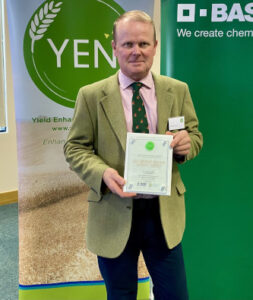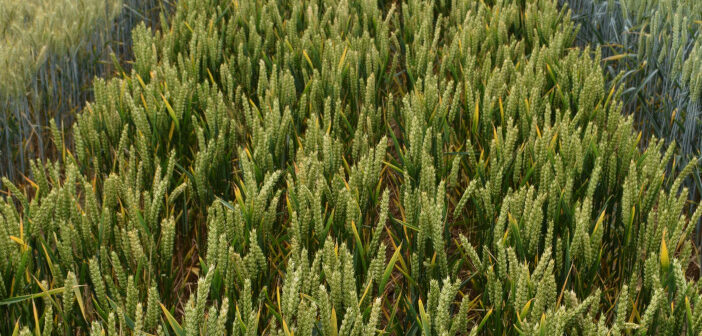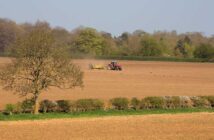Crusoe has scooped the top three positions in the Yield Enhancement Network (YEN) Milling Wheat Quality awards.
Despite being on the AHDB Recommended List for 12 years the Group 1 variety is still liked by growers and millers alike due to its consistent yield and quality.
First place went to Richard Budd who grows around 220 hectares of the variety across 1,400 hectares in Kent and Sussex. His focus is on quality Group 1 and 2 wheats, supplying local flour mills and export markets.
“We’ve only been growing Crusoe for three or four years, as previously we had been doing really well with KWS Zyatt and Skyfall. But, they both became uneconomic to grow due to their disease profiles, so last year we made the decision to go completely with Crusoe, which now accounts for one-third of our wheat area, alongside KWS Extase and Mayflower for the remainder.
“So far, Crusoe has served us well. It’s yielded well, is relatively clean and easy to manage, stands well and has a good specific weight, protein, and Hagberg. It’s a solid, stable variety.”
With milling wheat premiums currently £72 per tonne above feed, and predicted to stay firm, Richard is cautiously optimistic for the 2024 harvest. “Admittedly, I’d like an extra 5% yield, but I understand UK flour millers may be less keen on that due to the potential protein dilution. We do need some new genetics in the Group 1 sector, but at the moment, Crusoe is our default variety.”
The right protein
Norfolk grower Chris Eglington won gold in 2022 and claimed silver in 2023, recording the highest grain protein of 13.7% and one of the highest specific weights at 78.2 kg/hl.
He also values the performance of Crusoe, following a tricky 2023 season. “Yes, it’s been around a while now, but it’s great to have a variety that we know how to manage and know will perform well.”
It followed an oilseed rape crop, with cultivations done with an 8m Väderstad Carrier prior to drilling on 14 September, then rolled and a residual herbicide applied. Variable rate potash, lime as required and nitrogen applications are used across the farm. However, Chris notes that this year will likely be challenging.
“We’re already towards the top of what we can apply in terms of nitrogen, so I don’t think our programme will change drastically. We’ve always found the highest yields come in years when we’ve managed to get nitrogen on early, and fortunately we did manage to apply the first lot of nitrogen during a narrow window in early February, and might apply some more in early March, depending on how the crop looks.”
Typically first wheats receive around 280kg of nitrogen per hectare, applied in four bouts of solid fertiliser and sometimes supplemented with liquid urea in June. Regular tissue testing is used to target these applications.
Richard also recognises the importance of early nitrogen to support tillering and biomass accumulation, and has seen good results from applying two large doses of 80-90kg when conditions allow in February, and then later in March or early April.
Disease free
Richard’s nutrition strategy is supported by a robust, preventative fungicide programme. He aims to keep upper and lower leaves free from disease for as long as possible, rather than relying on the flag and leaf two to build yield.
“With our direct/ strip-till system, we find that if we can keep leaves 3, 4, and even 5 and 6 relatively clean throughout the year, they are still contributing quite a lot to final yield, right up to cheesy ripe stage.
“That said, we’re not applying maximum rate fungicides all of the time; decisions are guided by what’s there at the time, and varietal choice. I like Crusoe; it is a relatively easy, clean variety, with good Septoria scores, and yellow rust is non-existent really.”
He noted that late-season brown rust is a concern, but is relatively easy to control thanks to a good range of chemistry available. “As an industry, we need to be looking more at genetics rather than a can.”
Confidence in the variety
Suffolk grower Edward Vipond says that Crusoe has become the go-to variety in the first wheat slot, thanks to its ability to regularly achieve milling specifications. He grew 160 hectares last season, and has increased this to 224 for 2024.
 “When you’re spending a lot of money on fertiliser to obtain a milling premium, applying 270-280 kg N/ha for example, you need confidence that the crop will deliver in terms of protein, and Crusoe does that. Protein is as much down to the variety’s genetics as how you manage it.
“When you’re spending a lot of money on fertiliser to obtain a milling premium, applying 270-280 kg N/ha for example, you need confidence that the crop will deliver in terms of protein, and Crusoe does that. Protein is as much down to the variety’s genetics as how you manage it.
“For us, even at yields of 10.5 t/ha, it will still regularly obtain 13.3-13.5% protein.”
He admitted that the wet summer in 2023 did pose some challenges for quality, with milling wheats prioritised for harvesting slightly earlier than normal. This caused some issues with threshing, including unthreshed tips ending up in the grain sample, but the benefits of hitting milling specification outweighed this.
“There aren’t that many other competitors in the Group 1 list at the moment. There are one or two coming in, but they’re yet to be proven and have got to do something special to knock Crusoe off. Crusoe suits our land and it delivers.”
He added that flexibility and attention to detail are key, particularly in terms of drilling date, seed rate, nutrition and other inputs. Crusoe is generally established in early October to reduce the risk of barley yellow dwarf viruses, with a seed rate of 325-350 seeds per m2.
However, drilling and cultivation equipment is tailored to the conditions at the time.
Following potatoes or onions, a plough and combination drill is used, while other fields may receive a non-inversion deep tine before drilling with a disc or tine machine.
“Every season is different, so we do what is required.
“Yield is still king, and if you can get decent yields of good spec milling wheat at a premium of £50-60/t, the return is still there. With the results we had from Crusoe last year, what’s not to like?”
Gold(Richard Budd) |
Silver(Chris Eglington) |
Bronze(Edward Vipond) |
|
| Yield | 11.9 t/ha | 10.5 t/ha | 10.4 t/ha |
| Moisture | 15.0 % | 14.4 % | 14.1 % |
| Protein | 13.6 % | 13.7 % | 13.3 % |
| Specific weight | 76.2 kg/hl | 78.2 kg/hl | 76.9 kg/hl |
| Hagberg | 334 | 368 | 349 |




